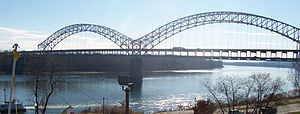
Interstate 64 (I-64) is an east–west Interstate Highway in the Eastern United States. Its western terminus is at I-70, U.S. Route 40 (US 40), and US 61 in Wentzville, Missouri. Its eastern terminus is at an interchange with I-264 and I-664 at Bower's Hill in Chesapeake, Virginia. I-64 connects the major metropolitan areas of St. Louis, Missouri; Louisville and Lexington in Kentucky; Charleston, West Virginia; and Richmond and Hampton Roads in Virginia. At 953.74 miles (1,534.90 km), I-64 is the second longest Interstate Highway not ending with a 5 or 0, after I-94.

New Albany is a city in Floyd County, Indiana, United States, situated along the Ohio River, opposite Louisville, Kentucky. The population was 37,841 as of the 2020 census. The city is the county seat of Floyd County. It is bounded by I-265 to the north and the Ohio River to the south, and is considered part of the Louisville, Kentucky Metropolitan Statistical Area. The mayor of New Albany is Jeff Gahan, a Democrat; he was re-elected in 2019.

The Wheeling Suspension Bridge is a suspension bridge spanning the main channel of the Ohio River at Wheeling, West Virginia. It was the largest suspension bridge in the world from 1849 until 1851. Charles Ellet Jr. designed it and supervised construction of what became the first bridge to span a major river west of the Appalachian mountains. It linked the eastern and western section of the National Road, and became especially strategically important during the American Civil War. Litigation in the United States Supreme Court concerning its obstruction of the new high steamboat smokestacks eventually cleared the way for other bridges, especially needed by expanding railroads. Because this bridge was designed during the horse-and-buggy era, 2-ton weight limits and vehicle separation requirements applied in later years until it was closed to automobile traffic in September 2019.

The Fred Schwengel Memorial Bridge is a 4-lane steel girder bridge that carries Interstate 80 across the Mississippi River between LeClaire, Iowa and Rapids City, Illinois. The bridge is named for Fred Schwengel, a former U.S. Representative from Davenport, Iowa and one of the driving forces behind the Interstate Highway Act. The structure was designed by the Iowa State Highway Commission, and was built by the Industrial Construction Company of Minneapolis (contractor), Gould Construction Company of Davenport, and Roy Ryan & Sons of Evanston, Indiana who was responsible for the substructure. The bridge opened on October 27, 1966, and is maintained by the Illinois Department of Transportation. It underwent a major rehabilitation project in 1996.

The Brent Spence Bridge is a double decker, cantilevered truss bridge that carries Interstates 71 and 75 across the Ohio River between Covington, Kentucky and Cincinnati, Ohio. The top deck carries Kentucky-bound traffic while the bottom deck carries Ohio-bound traffic.

The Hernando de Soto Bridge is a tied-arch bridge carrying Interstate 40 across the Mississippi River between West Memphis, Arkansas, and Memphis, Tennessee. The design is a continuous cantilevered cable-stayed steel through arch, with bedstead endposts. Memphians also call the bridge the "New Bridge", as it is newer than the Memphis & Arkansas Bridge downstream, and the "M Bridge", due to its distinctive shape. It is of similar construction to the Sherman Minton Bridge between Louisville, Kentucky, and New Albany, Indiana.
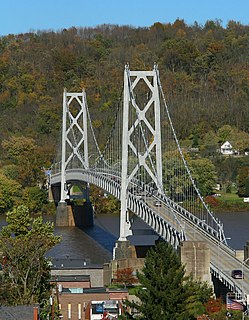
The Simon Kenton Memorial Bridge is a suspension bridge built in 1931 that carries U.S. Route 62 across the Ohio River to connect Maysville, Kentucky with Aberdeen, Ohio. Its main span is 1,060 feet long, and the total length of the bridge is 1,991 feet. The bridge was designed by Modjeski and Masters and was open to traffic on November 25, 1931. Tolls were collected from the opening of the bridge until 1945.

The Big Four Bridge is a six-span former railroad truss bridge that crosses the Ohio River, connecting Louisville, Kentucky, and Jeffersonville, Indiana. It was completed in 1895, updated in 1929, taken out of rail service in 1968, and converted to bicycle and pedestrian use in 2014. The largest single span is 547 feet (167 m), with the entire bridge spanning 2,525 feet (770 m). It took its name from the defunct Cleveland, Cincinnati, Chicago and St. Louis Railway, which was nicknamed the "Big Four Railroad".
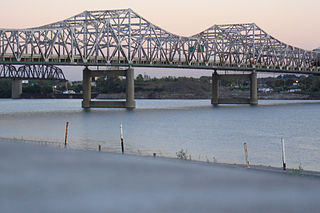
The John F. Kennedy Memorial Bridge is a six-lane, single-deck cantilever bridge that carries southbound Interstate 65 across the Ohio River, connecting Louisville, Kentucky and Jeffersonville, Indiana. The main span is 700 feet (213 m) and the bridge has a total length of 2,498 feet (761 m). The span carries six southbound lanes. It is named after U.S. President John F. Kennedy.

The Milton–Madison Bridge is a continuous truss bridge that connects Milton, Kentucky and Madison, Indiana. It carries approximately 10,000 cars a day. The old structure was replaced with a completely new continuous truss which was constructed on temporary piers adjacent to the operational span between 2011 and 2012 and slid into place after demolition of the old span using a construction method called "truss sliding." The new crossing opened to vehicle traffic in April 2014, and a pedestrian sidewalk opened that October.
The Ohio River Bridges Project was a transportation project in the Louisville metropolitan area involving the reconstruction of the Kennedy Interchange, the completion of two new Ohio River bridges, and the reconstruction of ramps on Interstate 65 between Muhammad Ali Boulevard and downtown Louisville.
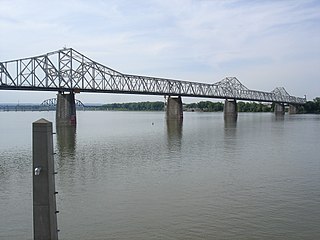
The George Rogers Clark Memorial Bridge, known locally as the Second Street Bridge, is a four-lane cantilevered truss bridge crossing the Ohio River between Louisville, Kentucky and Jeffersonville, Indiana, that carries US 31.

The Fourteenth Street Bridge, also known as the Ohio Falls Bridge, Pennsylvania Railroad Bridge, Conrail Railroad Bridge or Louisville and Indiana (L&I) Bridge, is a truss drawbridge that spans the Ohio River, between Louisville, Kentucky and Clarksville, Indiana.

The Kentucky & Indiana Bridge is one of the first multi modal bridges to cross the Ohio River. It is for both railway and common roadway purposes together. By federal, state, and local law railway and streetcar, wagon-way, and pedestrian modes of travel were intended by the City of New Albany, City of Louisville, State of Kentucky, State of Indiana, the United States Congress, and the bridge owners. The K & I Bridge connects Louisville, Kentucky to New Albany, Indiana. Constructed from 1881 to 1885 by the Kentucky and Indiana Bridge Company, the original K&I Bridge opened in 1886. It included a single standard gauge track and two wagon ways, allowing wagons and other animal powered vehicles to cross the Ohio River by a method other than ferry for the first time. At the time motorized vehicles were virtually nonexistent. The K&I Bridge company also owned a ferry boat operation during both the 1st and 2nd bridge; eventually that operation was sold as the bridge's success largely outmoded boat usage.
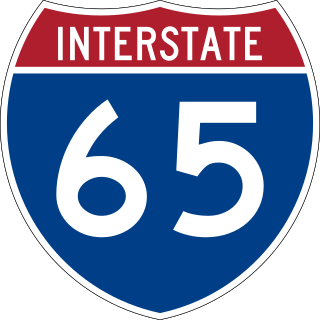
Interstate 65 (I-65) enters the US state of Kentucky five miles (8.0 km) south of Franklin. It passes by the major cities of Bowling Green, Elizabethtown, and Louisville before exiting the state.

Interstate 64 (I-64) in the US state of Indiana is a major east–west highway providing access between Illinois and Kentucky. It passes through southern Indiana as part of its connection between the two metropolitan areas of St Louis, Missouri, and Louisville, Kentucky.
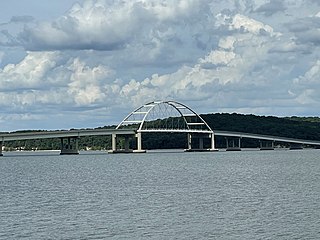
Eggner Ferry Bridge, also known as Eggner's Ferry Bridge, is a four-lane bridge in Trigg and Marshall counties in the U.S. state of Kentucky. The current through-arch bridge opened to traffic on April 7, 2016, replacing a two-lane bowstring truss bridge constructed in 1932. The bridge carries US 68 and Kentucky Route 80 across Kentucky Lake. The main span of the original 1932 bridge collapsed on January 26, 2012 after it was hit by a ship. There were no injuries. The bridge was repaired and reopened to traffic on May 25 of that year. On the morning of July 25, 2016, the middle four spans of the old Eggner's Ferry Bridge were brought down using controlled explosives.
The following is a timeline of the history of the city of Louisville, Kentucky, USA.

The Abraham Lincoln Bridge is a six-lane, single-deck cable-stayed bridge carrying northbound Interstate 65 across the Ohio River, connecting Louisville, Kentucky, and Jeffersonville, Indiana. The main span is 700 feet (213 m) and the bridge has a total length of 2,100 feet (640 m). It is named after U.S. President Abraham Lincoln, who was born in Kentucky and grew up in Southern Indiana.
The Lewis and Clark Bridge is a bridge that crosses the Ohio River northeast of downtown Louisville, Kentucky and is part of a ring road around the Louisville metropolitan area, connecting two previously disjointed segments of Interstate 265. It was known as the East End Bridge for 30 years since its conception and while under construction, and renamed by Indiana officials on the day of its opening, December 18, 2016. The bridge provides for walking and bicycling. For motor vehicles, tolling began on December 30, 2016.
